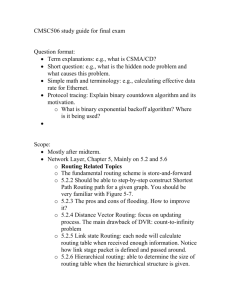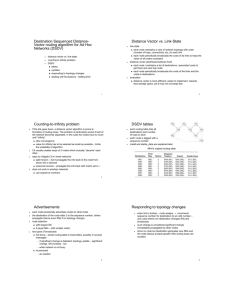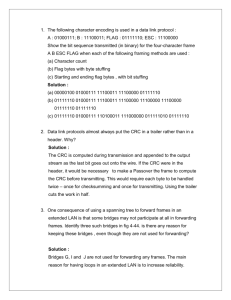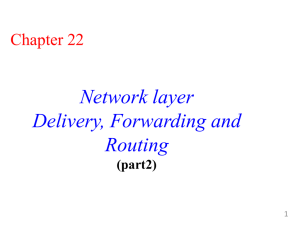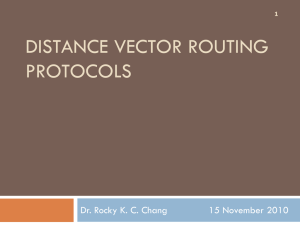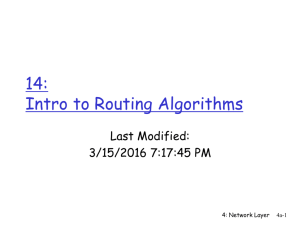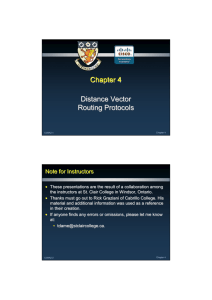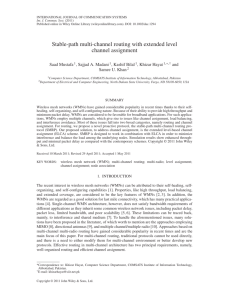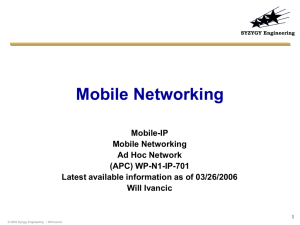www.bookspar.com | Website for Students | VTU - Notes
advertisement
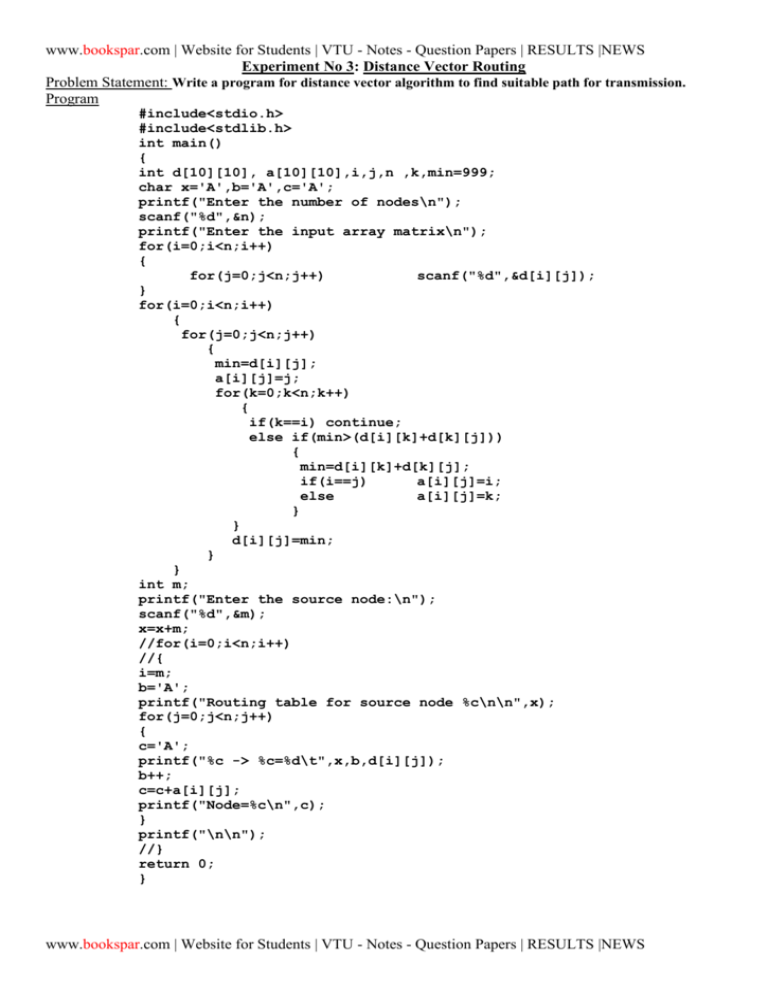
www.bookspar.com | Website for Students | VTU - Notes - Question Papers | RESULTS |NEWS
Experiment No 3: Distance Vector Routing
Problem Statement: Write a program for distance vector algorithm to find suitable path for transmission.
Program
#include<stdio.h>
#include<stdlib.h>
int main()
{
int d[10][10], a[10][10],i,j,n ,k,min=999;
char x='A',b='A',c='A';
printf("Enter the number of nodes\n");
scanf("%d",&n);
printf("Enter the input array matrix\n");
for(i=0;i<n;i++)
{
for(j=0;j<n;j++)
scanf("%d",&d[i][j]);
}
for(i=0;i<n;i++)
{
for(j=0;j<n;j++)
{
min=d[i][j];
a[i][j]=j;
for(k=0;k<n;k++)
{
if(k==i) continue;
else if(min>(d[i][k]+d[k][j]))
{
min=d[i][k]+d[k][j];
if(i==j)
a[i][j]=i;
else
a[i][j]=k;
}
}
d[i][j]=min;
}
}
int m;
printf("Enter the source node:\n");
scanf("%d",&m);
x=x+m;
//for(i=0;i<n;i++)
//{
i=m;
b='A';
printf("Routing table for source node %c\n\n",x);
for(j=0;j<n;j++)
{
c='A';
printf("%c -> %c=%d\t",x,b,d[i][j]);
b++;
c=c+a[i][j];
printf("Node=%c\n",c);
}
printf("\n\n");
//}
return 0;
}
www.bookspar.com | Website for Students | VTU - Notes - Question Papers | RESULTS |NEWS
www.bookspar.com | Website for Students | VTU - Notes - Question Papers | RESULTS |NEWS
Output
[nags@localhost NPL]$ ./a.out
Enter the number of nodes
4
Enter the input array matrix
0
5
2
1
5
0
2
2
2
2
0
3
1
2
3
0
Enter the source node:
3
Routing table for source node D
D -> A=1
Node=A
D -> B=2
Node=B
D -> C=3
Node=C
D -> D=0
Node=D
Theory
Routing algorithm is a part of network layer software which is responsible for deciding which output line an
incoming packet should be transmitted on. If the subnet uses datagram internally, this decision must be made anew for
every arriving data packet since the best route may have changed since last time. If the subnet uses virtual circuits
internally, routing decisions are made only when a new established route is being set up. The latter case is sometimes
called session routing, because a rout remains in force for an entire user session .
Two algorithms in particular, distance vector routing and link state routing are the most popular. Distance vector
routing algorithms operate by having each router maintain a table (i.e., vector) giving the best known distance to each
destination and which line to get there. These tables are updated by exchanging information with the neighbors.
The distance vector routing algorithm is sometimes called by other names, including the distributed Bellman-Ford
routing algorithm and the Ford-Fulkerson algorithm, after the researchers who developed it (Bellman, 1957; and Ford
and Fulkerson, 1962). It was the original ARPANET routing algorithm and was also used in the Internet under the RIP
and in early versions of DECnet and Novell’s IPX. AppleTalk and Cisco routers use improved distance vector
protocols.
In distance vector routing, each router maintains a routing table indexed by, and containing one entry for, each
router in subnet. This entry contains two parts: the preferred out going line to use for that destination, and an estimate
of the time or distance to that destination. The metric used might be number of hops, time delay in milliseconds, total
number of packets queued along the path, or something similar.
The router is assumed to know the “distance” to each of its neighbor. If the metric is hops, the distance is just one
hop. If the metric is queue length, the router simply examines each queue. If the metric is delay, the router can measure
it directly with special ECHO packets that the receiver just time stamps and sends back as fast as possible.
www.bookspar.com | Website for Students | VTU - Notes - Question Papers | RESULTS |NEWS




